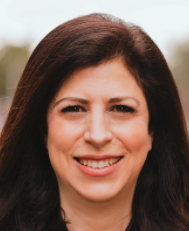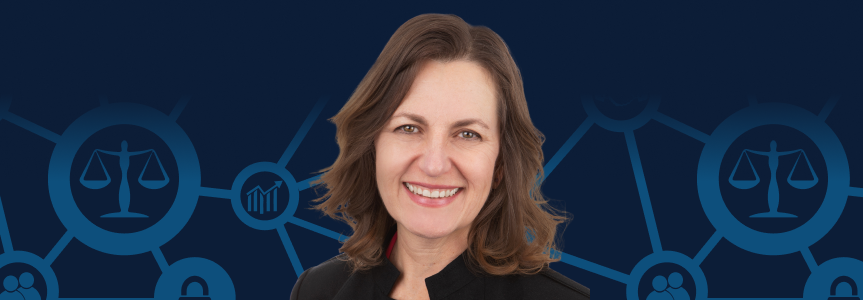Beyond the Law: Meet our New Chief Legal Officer, Shanti Ariker
Some may believe that when it comes to matters of the law, things are black and white. However, when it comes to managing the legal nuances amongst various geographies around the globe, each with a unique history, cultural and religious philosophy, plus governing bodies, there are many shades of gray that need to be navigated.
Legal systems have been essential for providing the rules of government, solving disputes, limiting social instability, and maintaining ethical standards of fairness and justice. I had a chance to sit down with my new Chief Legal Officer, Shanti Ariker, to learn a bit more about her as a person and as a leader, plus her passion for people, technology, and the law. Here is what I learned.
What do you find most exhilarating about your legal career?
I really enjoy problem-solving. Working within a business, you really get to know the issues that the business faces and the objectives that the leaders have for the business. Finding solutions to enable the company to accomplish those goals when the legal landscape can be hard to navigate is what I find exciting. Working on cutting-edge legal areas such as large language models like ChatGPT and how legal principles apply is also really interesting. I love working in technology because there is always something new to learn and apply legal principles in evolving ways.
What was the most gratifying moment in your legal career? Share what happened and why that was special to you.
My first big case in court was representing an Afghani refugee who had been waiting for his trial for years. I was able to get his asylum granted after a lot of work digging into his unfortunate story and presenting it to the judge. I felt really great about helping someone move their life forward and at the same time, I also learned so much about how to be persuasive in court and present a case from start to finish. As a result of that formative experience, as I have grown in-house teams, I have always tried to support pro bono practice to continue to help people who would otherwise not have access to justice.
Why JFrog and why now?
When I heard about this opportunity, I was intrigued by the thought of joining JFrog, as a high-growth company on its way to $1B. After some time at Salesforce, I became the General Counsel of Salesforce.org, at the time, a stand-alone social enterprise company earning less than $100M. During my tenure, we grew the business to more than $250M in ARR, which was an exciting ride. I joined Zendesk just as it hit the $1B mark in revenue. While these businesses were at different stages of growth, each had to undergo notable changes both in terms of internal operations and policies to ensure the company could properly scale to that next phase of growth. It was exciting and challenging at the same time, which made it memorable.
What is your philosophy for guiding your leadership team through legal challenges and establishing policies?
When joining a new company and building a team that’s ready for what’s next, it’s important to first understand the culture, the people, and where the company is at in its evolution. It’s possible that what’s worked up until now may not be what the company needs to get to that next level, but it doesn’t mean what was done was wrong and it shouldn’t be discarded or belittled. Doing so can be instantly discouraging to the team. Rather, it’s about learning, understanding, and then working with the team to evolve practices together versus making decisions on your own based solely on previous experience. Each company is different, and what may have worked at one company doesn’t guarantee it’ll work as effectively for another.
The other philosophy that guides me is being data-driven. Utilizing metrics is a good starting point for assessing what’s working and where there are areas for improvement, but it needs to be complemented with input from the team. For example, determining if you need more staff. The legal team is a service provider for the rest of the company, so you want to make sure you have the right ratio of legal resources to meet business demands. Taking an inventory of your volume of customer contracts, vendor agreements, compliance audits, rate of acquisitions, etc. is one metric, but you also have “human metrics” to consider: if any employee gets sick, has a life event that takes them out of the office for several days, weeks, or changes their working hours, they get called to an audit for several days, and so on. It’s important to work both within the legal team and in partnership with company leadership to assess long-term business needs and then establish principles and practices that will help move the company forward both operationally and in terms of policy.
A Chief Legal Officer oversees new and evolving policies, company growth strategies, managing the budget and the department, but first and foremost, I am leading a team. It’s important to take the human element into account, keep employees engaged, challenged and appreciated, and to provide them coaching and guidance so they can grow in their careers. Doing so will help keep them excited to come to work every day.
You’ve worked with a lot of rapid-growth software companies throughout your career. Have you seen any similarities between them in terms of legal needs at different stages of growth?
Sure, there are some similarities, but no company’s journey is the same. When you have a company moving from the seedling or start-up stage through IPO, or from $1M to a billion, 500 employees in one country to 5,000 employees across many different countries, there are some important legal and compliance measures that need to be put in place. But oftentimes, what I’ve seen to be the even greater challenge is unburdening the organization from old processes that keep the team bogged down in unnecessary efforts. I love the concept of “Beginner’s Mind” — taking a fresh look at things, even if you have been with the business for a while. Essentially, this is a way of thinking about how you would design things for today versus how they may have worked well in the past. For example, is it realistic to require the same legal review cycle for a $5,000 marketing vendor agreement versus a multi-million dollar, multi-year customer contract? Taking a risk-based approach to our legal practices is just as much about being practically-minded in all areas as it is about being protected.
What do you see as the biggest opportunity for a company like JFrog?
I imagine that there are some challenges, like other companies I have joined, in scaling the legal resources while keeping an eye on working efficiently as the company continues to grow revenue domestically and internationally. But as I have said, I can’t really know today what the opportunities are before I have time to go on a listening tour and learn from the people who built the company where their challenges are — what is working well and what could benefit from a change.
Your bio notes that you have a deep commitment to diversity and inclusion. Can you talk a bit about how you try to share that commitment in your working environment?
It’s important to have diverse perspectives within a company and I like to see women and underrepresented people in leadership, both in my department and throughout the company. For example, at Zendesk we were working on our Mansfield 3 certification, which measures whether legal departments have affirmatively considered historically underrepresented lawyers — women lawyers, LGBTQ+ lawyers, lawyers with disabilities, and underrepresented racial and ethnic lawyers — for the legal department’s top roles and outside counsel leadership. There are fewer than 50 companies in the country that have even achieved Mansfield 2.0 as in-house legal teams, so I’m very proud that we were one of them.
Just as important as bringing in diverse talent is ensuring people feel included. That is why I was excited to be the executive sponsor for the women in engineering and women in leadership groups at Zendesk, and was on the board of the Zendesk Foundation that regularly volunteered and donated to outside organizations that also value diversity and inclusion. On behalf of my prior organizations, I’ve been a signatory every year for social justice areas and a pro bono legal advocate, advocating for the provision of legal aid for those who would otherwise not be able to afford legal services.
Cybersecurity regulations are increasing almost daily – and they vary greatly from country to country – how do you keep abreast of these rapidly changing requirements?
The cyber threat facing our nation is growing more dangerous and complex every day, making it challenging to keep up. I’m also a public company board member and on the risk committee, so it’s imperative for me to keep abreast of cybersecurity regulations. To remain current, I subscribe to a variety of updates from law firms and security consulting providers, as well as belong to several general counsel communities that keep each other abreast of evolving regulations and emerging threats. These communities also provide forums for asking questions and exchanging best practices with fellow legal professionals.





